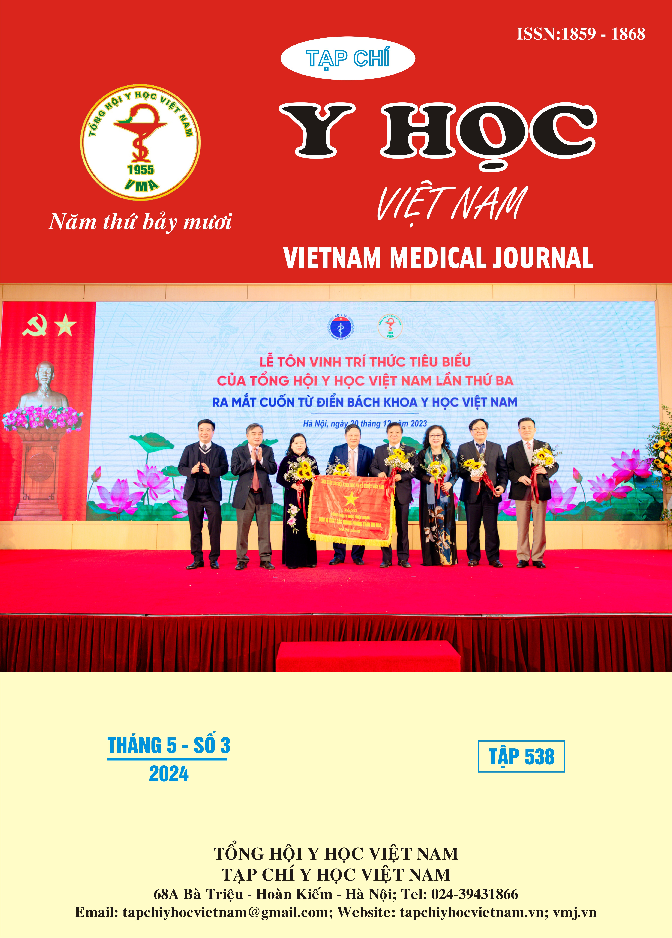MỐI LIÊN QUAN GIỮA THỤ THỂ ESTROGEN VỚI ĐẶC ĐIỂM LÂM SÀNG Ở BỆNH NHÂN LUPUS BAN ĐỎ HỆ THỐNG
Nội dung chính của bài viết
Tóm tắt
Mục tiêu: Xác định mối liên quan giữa sự hiện diện của thụ thể estrogen α (ERα) tại thương tổn da và đặc điểm lâm sàng của bệnh nhân lupus ban đỏ hệ thống. Đối tượng và phương pháp: Nghiên cứu loạt trường hợp bệnh trên 65 bệnh nhân nữ được chẩn đoán lupus ban đỏ hệ thống đến tại bệnh viện Da liễu Trung ương từ tháng 01/2022 đến tháng 8/2023. Trong đó, 36 bệnh nhân được làm mô bệnh học tổn thương da và nhuộm hóa mô miễn dịch để phát hiện thụ thể estrogen α. Kết quả: Tuổi trung bình mắc bệnh là 30,72±15,1. Bệnh nhân lupus ban đỏ hệ thống có tổn thương da cấp tính gặp nhiều nhất chiếm 60%, sau đó là bán cấp 27,7% và mạn tính 12,3%. Tổn thương ban cánh bướm gặp nhiều nhất trong các tổn thương da đặc hiệu (36,9%), tổn thương nhạy cảm ánh sáng chiếm nhiều nhất trong tổn thương da không đặc hiệu (52,3%).Tỷ lệ thụ thể ERα tại tổn thương da dương tính ở 38,9% trường hợp và âm tính ở 61,1% trường hợp. Không có sự liên quan giữa thụ thể ERα với nhóm tuổi, phân loại tổn thương da do lupus, tổn thương da đặc hiệu, tổn thương da không đặc hiệu. Kết luận: Tổn thương da rất thường gặp, đa dạng ở bệnh nhân lupus ban đỏ hệ thống, Thụ thể estrogen α tại tổn thương da, dương tính ở 38,9% bệnh nhân. Không tìm thấy mối liên quan giữa sự hiện diện của thụ thể ERα tại thương tổn da và đặc điểm lâm sàng của bệnh nhân SLE.
Chi tiết bài viết
Từ khóa
thụ thể ERα, lupus ban đỏ hệ thống, đặc điểm lâm sàng.
Tài liệu tham khảo
2. Olsen NJ, Kovacs WJ. Gonadal steroids and immunity. Endocr Rev. 1996;17(4):369-384. doi: 10.1210/edrv-17-4-369
3. Petri M, Robinson C. Oral contraceptives and systemic lupus erythematosus. Arthritis Rheum. 1997;40(5):797-803. doi:10.1002/art.1780400504
4. Yang LY, Huang WJ, Chen WP, Fu LW, Lin CY. Does parenteral oestrogen therapy flare up disease activity in patients with systemic lupus erythematosus complicated by haemorrhagic cystitis? Rheumatology. 1999;38(4):372-373.
5. Casoli P, Tumiati B, La Sala G. Fatal exacerbation of systemic lupus erythematosus after induction of ovulation. J Rheumatol. 1997;24(8):1639-1640.
6. Mok CC, Wong RW, Lau CS. Ovarian failure and flares of systemic lupus erythematosus. Arthritis Rheum. 1999; 42(6):1274-1280. doi: 10.1002/1529-0131(199906)42: 6<1274::AID-ANR26>3.0.CO;2-B
7. Levin ER. Plasma membrane estrogen receptors. Trends in Endocrinology & Metabolism. 2009; 20(10): 477-482.
8. Kisiel B, Kosińska J, Wierzbowska M, et al. Differential association of juvenile and adult systemic lupus erythematosus with genetic variants of oestrogen receptors alpha and beta. Lupus. 2011; 20(1): 85-89. doi:10.1177/ 0961203310381514
9. Drehmer MN, Andrade D, Pereira IA, et al. Estrogen receptor alpha gene (ESR1) polymorphism can contribute to clinical findings in systemic lupus erythematosus patients. Lupus. 2017; 26(3): 294-298. doi:10.1177/ 0961203316668041
10. Kisiel B, Kosińska J, Wierzbowska M, et al. Differential association of juvenile and adult systemic lupus erythematosus with genetic variants of oestrogen receptors alpha and beta. Lupus. 2011; 20(1): 85-89. doi:10.1177/ 0961203310381514


